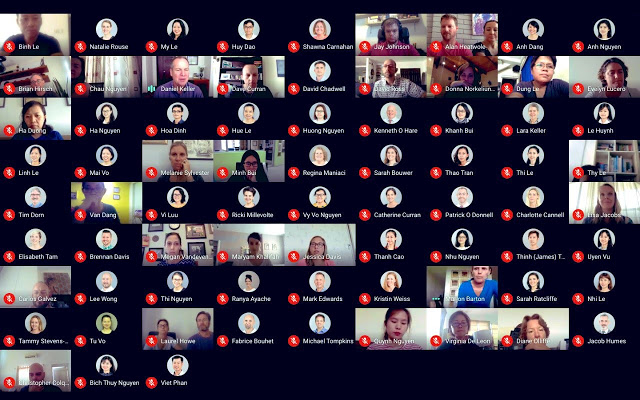Why human connection is more important during crises
I’m not sure if this is going to work.
We are doing a session on why human connection is vital to digital transformation success.
I’ve spoken on this many times, and it’s received positive comments and results. However, now is not like any other time.
Now, we are all working remotely and home isolated due to Covid19 and the attempt for countries to control this global pandemic. Of course, we pitched this session months ago, when we were all still able to fly, go to live events, and meet with customers and partners face to face.
As soon as I click on the first slide, the irony of talking about human connection during a time of massive human disconnection stares in our faces.
It’s an image of two arms stretching toward each other, shaking hands. Usually, my witty headline on this slide is “digital handshakes cannot replace the real thing.”
Whoops.
So, I just admit the dichotomy head on and repeat my typical headline, and then ask the audience a question.
“Why is that the case?” I ask.
“Because hand shakes, when we firmly grasp another human’s hand and look at them in the eye, help develop trust,” I answer, imagining my audience nodding their heads.
“After receiving a firm handshake from someone, you automatically feel like you’ve made a connection.
The physical contact makes it personal, while also conveying friendship and good intent.”
Building trust when we are physically disconnected
I joke that this is only the case with a firm handshake of course, not one of those limp, fish handshakes, as I call them.
“Now, we must earn that trust in different ways,” I continue.
“Our need to continue on the path of digital transformation does not stop. In fact, we are undergoing more change than ever before,” I add.
“Therefore, the need for trust is also greater than ever.”
“In a climate that combines uncertainty with aggressive innovation, and the need to learn or relearn a new trend,
trust is one of the only stable principles we can count on …”
DANIEL NEWMAN
PRINCIPAL ANALYST, FUTURUM RESEARCH
How do we develop trust as leaders, colleagues, clients, vendors, and even parents or friends during a time when we are so physically apart and isolated?
We need to do even more to connect to each other’s humanity.
Touching people might now be virtual, but we need to ensure we are connecting via whatever virtual means we can.
More frequently, not less.
For longer periods, not shorter.
Over the last couple of months, I’ve seen an incredible hunger and need for people to just talk, ask questions, and “be” with other people.
They want reassurance that the world isn’t completely falling apart.
For many, they want anything that speaks to normalcy.
Crisis Leadership requires personal connection
In fact, this period has opened a door to even greater personal awareness.
Most of us had never seen the inside of our colleague’s homes.
Now, after the hundredth video conference call, we know the different rooms in our team’s houses. Who has dogs and cats. The names of their children, significant others, parents, animals, etc. We know who has a second home and where it is, and we know when they are there instead of their main home, as the views change.
We see just about everybody in their natural state: unshowered, no make up, and hair dye long expired or personally redone. We no longer find it surprising when a colleague has a cold beer or glass of wine in their hand for the 4:00pm meeting.
Also, the geographic differences seem to be less far apart. A call at 8pm with Asia no longer seems as strange. In fact, the other day I started my morning at 4am with Ireland and ended my day at 7pm with Singapore. Coffee on one end and a glass of wine on the other. It’s all part of a long, yet seemingly normal, blurry day.
What does all this mean for us as leaders?

Google Meet grid view for large team meetings
6 Ways Leaders can build trust now and always
I’ve identified and have implemented six key areas that I believe are essential for leaders to not only manage through this time, but inspire and maintain the morale of their teams.
1. Increase your availability and authenticity
It’s 5am Seattle time. I am in my home office, cup of coffee at hand, jumping on a Bluejeans web conference call.
There are already three colleagues there.
“Good morning early birds,” I say to them.
To be fair, it’s afternoon for one person, who lives in Amsterdam.
It’s Friday, and I’m expecting a light turnout. However, two minutes later, there are 25 people on the call. I love the Google Meet grid view, as you can see everyone who has their camera on, and in this case, it’s everyone. The laughter begins almost immediately. Lovely laughter.
Right after we all went remote, I offered to do an “ask MD anything” session with my team. To my surprise, the team unanimously said “yes, you should do that.”
Now, I hold these video meetings at different times of the day and week, and the agenda is just as it sounds. In other words, there is no agenda. Whoever shows up talks about whatever is on their mind, and asks me whatever questions they have.
Often, these meetings turn into in-depth conversations about family and work balance, quarantine jokes, or sometimes, somber stories. Other times, team members pose serious questions about salaries, retention, bonuses, hiring, and just overall financial stability.
I give this example, because as leaders in today’s environment, we need to be “present” in new ways. I am experiencing the importance of this every day. Since we can no longer walk the halls, we need to create opportunities for those unofficial conversations. Think about how you can maintain your “open door policy” or flexible office hours virtually.
2. Be open and transparent with information sharing
In addition to being present, think about “how” you show up and communicate, authentically. Let go of the polish you might normally have at the office.
Who cares if they see you with no make-up, in your workout clothes, with a glass of wine in your hand. In fact, this level of personal authenticity makes you and your leadership more accessible and trustworthy.
Whether you are a leader who readily shares information with your teams or not, this is a good time to focus on your open communication. Change is the greatest source of fear for humans. Every day, our teams are experiencing massive change, or worse, no change at all to what feels like a desperate situation.
When we show up for our people in more casual, accessible ways, we need to also share information more openly.
“Trust is built on telling the truth, not telling people what they want to hear”
My default is to tell my team everything I know and have heard during executive briefings, unless the information is confidential or has financial repercussions.
These are professionals, and by trusting them with whatever deeper knowledge you have around the quarterly results, budgets, Covid response, customers, and other areas of the business, helps them feel empowered and increases their confidence in the company, your leadership, and their own abilities.
3. Create virtual team building opportunities
In addition to providing more virtual collaboration time to hang out with one another and be visible as a leader, we need to do more to help everyone feel part of a team.
Research proves that this period of isolation has increased levels of depression and feelings of being alone or disconnected. On this front, I’ve seen many teams create virtual coffee chats or happy hours. Others have started gamifying all hands and team meetings, using apps or polling tools to improve collaboration and participation by everyone. Another idea is to choose a team passion project or non-profit focus.
One team I know decided to come together to help a women’s shelter where they had volunteered previously. Everyone on the team, if they were able, donated items from the shelter’s Amazon page, and included a small message that said it was from their team. This not only built a team spirit but also helped everyone feel like they were making a difference during this difficult time. The shelter, of course, was thrilled, since its supplies and donations were running low.
4. Develop Virtual Workshops or TrainingMember Login
Perhaps even harder than our virtual team environment is our inability to meet face-to-face with our customers and clients. In fact, often my role is helping a sales team establish better executive relationships by meeting a customer for dinner or lunch or during a conference.
This allows us to get to know each other outside of a sales situation, and helps build trust. How can we do this virtually?
At Red Hat, the company is finding creative ways to duplicate or at least come close to those more intimate customer interactions, virtually. Its impactful executive briefing center (EBC) meetings are being tested using a virtual platform that includes not only typical video conferencing but also chat, virtual whiteboards, dynamic presentations, and other technology in an attempt to adapt what is usually an agile physical environment to one in a virtual domain.
Companies all over the globe are developing ways to make their training, workshops, hands-on labs, conferences and sales meetings virtual. I’m sure you are doing the same.
My only advice here is do your homework and training. Make sure the platform and tools perform in the way you need them to and can scale when under pressure. I’ve seen many events crash in this new virtual reality, both literally and figuratively. While your customers will have patience with you as you work to provide services in new ways, their patience will have limits.
With whatever finances you have to invest in virtual platforms, choose them carefully and make sure your staff is trained appropriately. No platform is perfect, but they are also not created equal.
5. Encourage direct feedback
Along with authentic communication by you as a leader, we should encourage direct, honest feedback to us. Why? Because people should be encouraged to tell the truth about how they are feeling, what they see going on, and any issues they are experiencing.
For example, maybe a person who reports to you is normally motivated by title and rewards. However, during this time of remote working, he is more concerned with work-life balance and being present for his children. This is vital, as maybe you need to figure out how to increase his work flexibility or personal time off limits, rather than focusing on his next bonus.
Talking with your employees in a candid, honest way will help ensure they are all still there when the economy and your company recover from the crisis. While many people are obviously happy to be employed, we still need to worry about employee health and retention.
During a crisis, we are more likely to experience Crucial Conversations, as the stakes are always high during times of change or stress. If you haven’t read this book or developed skills for difficult conversations, now is a perfect time to start!
Also, do not let this period of remote connections lead to fewer career or development conversations. Stay on track with your reviews and development plans. In fact, perhaps you have more time to focus on these than before. (I say this hopefully, as I have found I have less time for this, not more, but I’m still trying.)
6. Embrace the speed of agility
During times of crisis leadership, we need to be able to constantly adjust what we are doing and how we are prioritizing. The market dynamics and global economy are changing on a regular, and sometimes daily, basis.
Some great examples are how Ford Motor Company, with car manufacturing demands dropping off during the global pandemic, retooled and retrained their manufacturing sites to build ventilators instead of cars.
This took a leader with the ability to handle risk and push through change. In doing so, Ford kept employees working as much as possible, while also providing a critical medical device that was vastly under-resourced.
This level of agility and fast adjustment might be new to you. It takes fast decision making and risk taking combined.
However, doing nothing during times of change or crisis results in greater problems or downturns. Putting our heads in the sand and hoping everything will get better has been shown to never work.
How do we become Double bottom line companies
Back to my session on Digital Transformation. I always end this presentation with a challenge for the audience, pushing them to think about not just what they do but how and why they do it.
In addition, I ask how we can all become “double bottom-line companies.” This is a term coined by Alan Gershenfeld, Founder/President of E-Line Media, and the author of Designing Reality. A great book I recommend, by the way.
A double bottom line organization is committed to BOTH positive financial returns AND meaningful social impact. In other words, we can make money and change the world for the better, at the same time. One does not have to be mutually exclusive of the other.
Capitalism for social good. I like that. Because, I believe that is the greatest human connection we can make. The way we will come out of this economic hardship will be a deeper connection between these two. In my humble opinion, capitalism is not the root of evil. It provides the opportunities and financial capability to do social good, if everyone chooses to do so.
Let’s all work to help businesses succeed, and to become double bottom-line organizations. Now and always.


